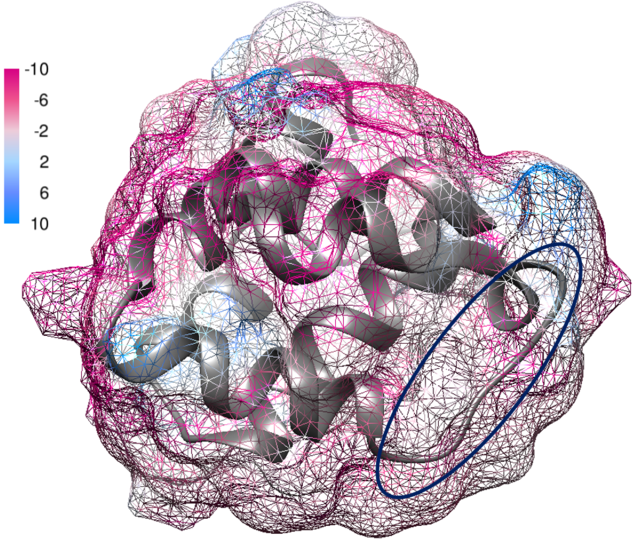Top Qs
Timeline
Chat
Perspective
Pyrin domain
Protein domain From Wikipedia, the free encyclopedia
Remove ads
A pyrin domain (PYD, also known as PAAD/DAPIN) is a protein domain and a subclass of protein motif known as the death fold, the 4th and most recently discovered member of the death domain superfamily (DDF). It was initially discovered in the pyrin protein, also known as marenostrin, which is encoded by MEFV. The mutation of the MEFV gene is the cause of the disease known as Familial Mediterranean Fever.[4] The domain is encoded in 23 human proteins and at least 31 mouse genes.[5]


Proteins containing a pyrin domain are frequently involved in programmed cell death processes, including pyroptosis and apoptosis.[6][7] Proteins that possess a pyrin domain interact with the pyrin domains of other proteins to form multi-protein complexes called inflammasomes, triggering downstream immune responses.[5]
Remove ads
Structure
Pyrin domains are a ~90 amino acid motif present only at the N-terminus of proteins. The core is composed of highly conserved hydrophobic residues surrounded by five or six alpha helices with α1→2 linkages. The hydrophobic core allows self-oligomerization into punctate or speckled filamentous formations.[5] Polar residues on the surface of the domain will enable the formation of the characteristic homotypic PYD-PYD interactions. Acidic residues are typically located in the α2 and α3 helices, while basic residues are located on the α1 and α4 helices. Compared to other members of the DDF, they contain a distinctly elongated α2-α3 loop. This loop, especially α3, is highly variable among PYDs of different proteins, which allows binding specificity with other PYDs of the same type.[5]
Remove ads
Function
Proteins containing PYDs function as cytosolic pattern recognition receptors (PRRs) that sense damage-associated molecular patterns (DAMPs) and pathogen-associated molecular patterns (PAMPs).[5] Homotypic interactions between PYDs in receptor and adaptor proteins trigger the downstream formation of the inflammasome.[4]
First, receptor proteins (such as NLRs and ALRs) are activated by their putative DAMP or PAMP ligands. These receptors undergo a conformational change, exposing their PYD.[8] Generally, an adaptor protein (ASC) containing both a PYD and a caspase recruitment domain (CARD) is recruited, forming a PYD-PYD electrostatic interaction with the receptor's domain. More ASC-PYDs spontaneously self-oligomerize and form a multi-protein complex called an inflammasome. Pro-caspase-1 and caspase-8 are activated through an induced proximity mechanism. Caspase activity regulates multiple downstream pathways to trigger pyroptosis and the secretion of pro-inflammatory cytokines.[4][8]
Remove ads
Types
Summarize
Perspective
Types of proteins containing a PYD include adaptors, apoptosis-associated speck-like protein containing a CARD (ASC), regulatory proteins such as pyrin or pyrin-only proteins (POPs), receptors like NOD-like receptors containing a pyrin domain (NRLPs), and AIM2-like receptors (ALRs).[5][8]
ASC
ASC is an adaptor protein that is part of apoptosis, pro-caspase 1 recruitment and activation, as well as NF-κB transcription factor activation. ASC contains only two domains: the PYD at the N-terminus and a CARD at the C-terminus. PYD interactions between ASC lead to oligomerization, forming puncta or "specks" that become visible microscopically.[7][9] The CARD recruits pro-caspase-1, which undergoes proximity-induced autocleavage to form the active caspase-1, which in turn triggers maturation of IL-1β and IL-18.[10]
NLRPs
NOD-like receptors exist in an inactive form until their ligand induces a conformational change. Some NLRs, such as NLRP1 and NLRP2, have a straightforward mechanism by which the receptor binds to a PAMP, triggering its activation, oligomerization and PYD-PYD ASC recruitment.[7][8] In contrast, NLRP3 (also known as cryopyrin) is the most well-studied NLR with a pyrin domain and has several diverse agonists. Proposed methods of its activation are more nuanced, involving intermediate effectors rather than a direct ligand-receptor interaction. An efflux of ATP due to tissue damage leading to an increase in Ca2+, mitochondrial reactive oxygen species production due to cellular stress and lysosomal rupture releasing excess H+ have all been proposed to inhibit different cofactors that normally inactivate NLRP3.[8]
ALRs
Absent in melanoma 2-like (AIM2-like) receptors function as recognition of foreign double-stranded DNA. Two ALRs with pyrin domains, AIM2 and IFI16, assemble inflammasomes; AIM2 in the cytosol and IFI16 moves between the nucleus and cytosol, functioning as a nuclear pathogen sensor.[11] Unlike NLRPs, which function in cytosolic PAMP and DAMP recognition, ALRs mainly act within the nucleus, oligomerizing along the DNA staircase.[8]
POPs
Pyrin-only proteins are unlike other PYD-containing proteins which contain a PYD with one or more other domains. Different POPs have electrostatic and structural similarities to the specific PYD they regulate.[5] Most are encoded near the same genes as the pyrin-containing proteins they inhibit; POP1 and POP2 are postulated to have arisen by exon duplication.[7] Since most inflammasomes are formed by aggregation due to PYD-PYD interactions, POPs instead bind to PYDs preventing polymerization and therefore regulating and/or resolving inflammation response.[5]
Remove ads
References
Wikiwand - on
Seamless Wikipedia browsing. On steroids.
Remove ads

